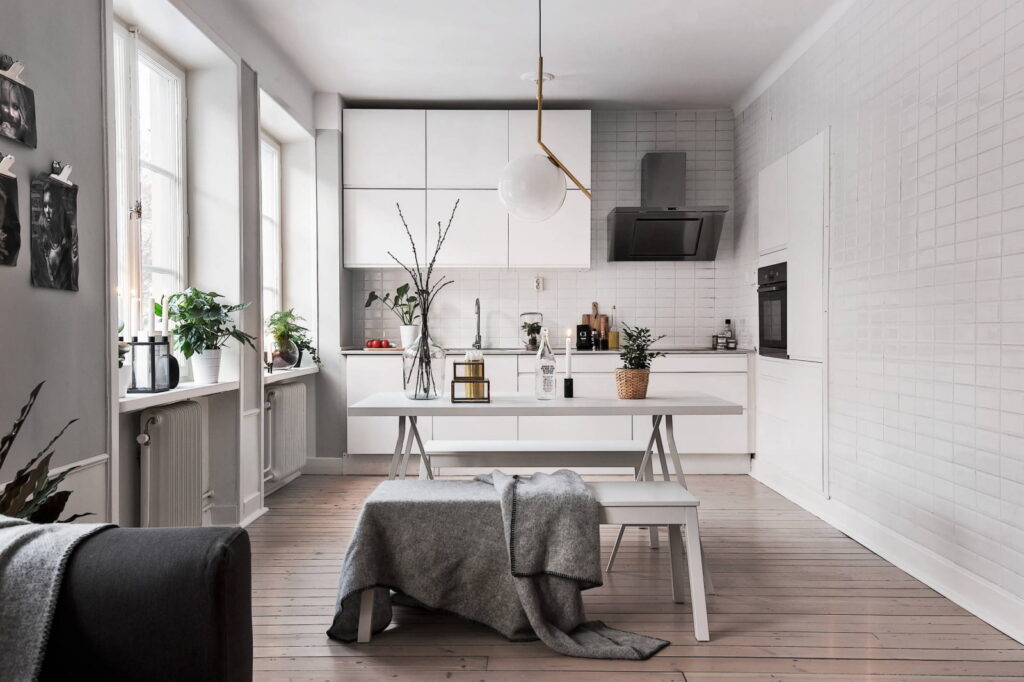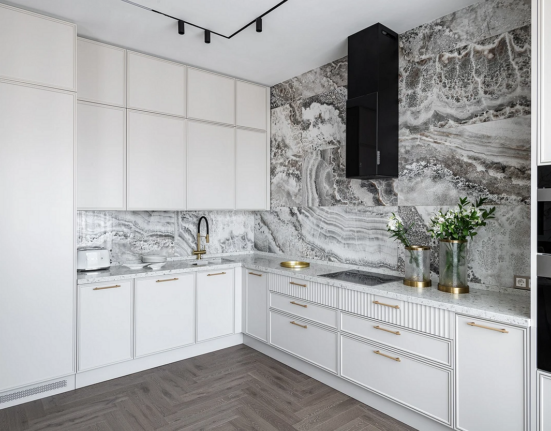What type of flooring is best for a kitchen – linoleum, tile, or perhaps cork? We delve into the materials and determine which flooring is more reliable and comfortable.
Criteria for choosing a kitchen floor covering?
The room where food is prepared is subject to much more contamination than the rest of the rooms in the apartment, so the floor should be:
- Durable, to withstand frequent washing and cleaning with household chemicals.
- Long-lasting, to withstand prolonged stress.
- Fireproof: under the influence of high temperature, it is important that the floor does not emit toxic fumes and does not ignite.
- Waterproof: porous coating absorbs moisture and grease and contributes to the development of various microorganisms, which should not be in the apartment.
What kind of floor can be used?
Before laying any material, it is necessary to make waterproofing, which will increase the protection of the room from water, and level the base. Let’s consider the most popular and practical types of floor coverings for the kitchen.
Linoleum
A cheap material with many advantages. It is laid exclusively on a flat prepared surface, otherwise all dents and irregularities will be noticeable. The wear of the coating depends on its characteristics: for the kitchen, you should choose class 31-34, which will last about 15 years.



The photo shows a studio kitchen in the loft style. The floor is covered with linoleum with imitation wood.
Linoleum has both pluses and minuses, let’s look at them in more detail:
Advantages:
- Has water-repellent properties.
- If the dishwasher or washing machine leaks, removing water will not be a problem.
- To lay linoleum, no special skills are required.
- Not susceptible to scratches, and if glassware falls on a quality coating, there will be no dents.
- Has good sound insulation.
Disadvantages:
- You can find a budget option, but such a material does not have a wealth of colors.
- On linoleum less than 0.08 inches (2mm) thick, dents from heavy furniture are formed.
- Over time, it is prone to deformation. The whole canvas needs to be replaced.
- Poor quality coating poorly imitates wood and stone.
Laminate
Quite an acceptable option for a kitchen, if you do not choose too cheap material (class 33 will do). It has many textures and colors, it can look like natural parquet.



The photo shows a kitchen in the style of modern classic, the floor of which is covered with laminate.
What other features does it have? The answers are below:
Advantages:
- Even a beginner can install laminate.
- Water-resistant laminate will not deform even after water gets on it.
- Durable, scratch-resistant, does not fade.
- Easy to clean, pleasant to the touch.
Disadvantages:
- Amplifies the sounds of footsteps if no underlay is used during installation.
- Water-resistant material is not afraid of high humidity, but over time it begins to swell and rot if water gets into the seams
- The joints of laminate for the kitchen are recommended to be treated with transparent sealant.
- I suggest looking more closely at the features of choosing laminate for an apartment.
Tile and Porcelain Tile
The most practical option for kitchen flooring. Ceramic tile is quite slippery and less durable, cracks may appear during operation. Porcelain tile is more resistant to mechanical stress and does not fade. It is recommended to choose dark grout so that the dirt between the seams is less noticeable.



In the photo is a kitchen in the Provence style, the floor of which is decorated with ceramic tiles with a patchwork pattern.
Let’s consider the operational characteristics of porcelain stoneware in more detail:
Advantages:
- Durability, resistance to chemicals.
- Richness of colors, shapes, and sizes.
- Can imitate wood, stone.
- Resistance to dirt, moisture, grease.
- Environmentally friendly material.
Disadvantages:
- It’s difficult to lay tiles without special preparation.
- If the room is not equipped with a heated floor system, the surface will be cold and unpleasant for the feet.
- Low sound insulation.
- High probability of chips if something heavy falls on the floor.
Wooden floor
This segment is represented by natural materials from wood: parquet and deck boards. Most designers love such a floor, but not everyone considers it suitable for the kitchen.



In the photo is a kitchen in the Scandinavian style, the floor of which is covered with natural boards. They soften the strict setting and add coziness to the interior.
We weigh all the pros and cons of wooden flooring:
Advantages:
- Environmentally friendly material.
- Expensive types of wood have high strength and aesthetics.
- The surface is pleasant and warm to the touch.
Disadvantages:
- Absorbs drops of water, grease, and odors. It’s hard to take care of wood.
- To increase the wear resistance of the parquet, it must be covered with a special protective compound.
- The seams between the boards over time diverge, it’s easy for water and dirt to penetrate there.
Poured floor
A relatively new and expensive way of arranging the floor in the kitchen. As a result of pouring, a uniform glossy surface is obtained without seams and drops.



The photo features a modern kitchen with a poured white floor.
Let’s consider the pros and cons of polyurethane coating:
Advantages:
- A huge variety of colors – any image can be applied to the non-woven synthetic material, which is then filled with a mixture.
- Easy to clean, scratch-resistant, impact-resistant.
- Has good water resistance.
- The polymer floor is durable, it can be repaired if damaged.
Disadvantages:
- Labor-intensive preparation of the base for filling.
- High price.
- Any dirt is noticeable on the glossy surface.
Cork Floor
Elastic material in rolls or slabs, made from ground wood. The surface, compressed with thermoreactive resins, has elasticity and roughness. The surface is covered with special protective compounds.

You should get to know this unusual material closer:
Advantages:
- Cork is silent, absorbs sounds well.
- Wear-resistant, does not deform.
- Has good heat conductivity.
- Does not absorb odors and fat, is not susceptible to fungus, is safe.
Disadvantages:
- It does not withstand prolonged water exposure.
- Dents from heavy object impacts may occur.
Combined Floor
Some kitchen owners combine two materials to make the floor as practical as possible without giving up their useful properties. Typically, wood or linoleum is combined, covering the dining area with a warmer coating, and tiles are laid in the cooking area.



There are several reasons in favor of this solution:
Advantages:
- Combined flooring combines all the advantages of different types of coverings.
- In a spacious kitchen, it serves as an excellent way of zoning.
- If a heated floor is planned, you can save some money by reducing the area.
Disadvantages:
- It is problematic to mask the junction, besides, dirt and dust accumulate there.
- This option is not suitable for tight kitchens.
- You need a great taste or the help of a specialist to successfully combine two materials.
Today, the construction market allows you to choose a floor covering without sacrificing aesthetics for practicality: kitchen owners just have to decide on their preferences and budget.






Leave feedback about this